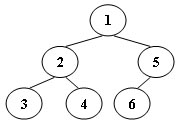https://pintia.cn/problem-sets/994805342720868352/problems/994805380754817024
An inorder binary tree traversal can be implemented in a non-recursive way with a stack. For example, suppose that when a 6-node binary tree (with the keys numbered from 1 to 6) is traversed, the stack operations are: push(1); push(2); push(3); pop(); pop(); push(4); pop(); pop(); push(5); push(6); pop(); pop(). Then a unique binary tree (shown in Figure 1) can be generated from this sequence of operations. Your task is to give the postorder traversal sequence of this tree.

Figure 1
Input Specification:
Each input file contains one test case. For each case, the first line contains a positive integer N (≤) which is the total number of nodes in a tree (and hence the nodes are numbered from 1 to N). Then 2 lines follow, each describes a stack operation in the format: "Push X" where X is the index of the node being pushed onto the stack; or "Pop" meaning to pop one node from the stack.
Output Specification:
For each test case, print the postorder traversal sequence of the corresponding tree in one line. A solution is guaranteed to exist. All the numbers must be separated by exactly one space, and there must be no extra space at the end of the line.
Sample Input:
6
Push 1
Push 2
Push 3
Pop
Pop
Push 4
Pop
Pop
Push 5
Push 6
Pop
Pop
Sample Output:
3 4 2 6 5 1代码:
#include <bits/stdc++.h>
using namespace std;
int N;
vector<int> in, post, pre, val;
void postorder(int root, int st, int en) {
if(st > en) return;
int i = st;
while(i < en && in[i] != pre[root]) i ++;
postorder(root + 1, st, i - 1);
postorder(root + 1 + i - st, i + 1, en);
post.push_back(pre[root]);
}
int main() {
scanf("%d", &N);
stack<int> s;
string op;
int cnt = 0;
for(int t = 0; t < N * 2; t ++) {
cin >> op;
if(op == "Push") {
int x;
scanf("%d", &x);
pre.push_back(cnt);
val.push_back(x);
s.push(cnt ++);
} else {
in.push_back(s.top());
s.pop();
}
}
postorder(0, 0, N - 1);
for(int i = 0; i < N; i ++) {
printf("%d", val[post[i]]);
printf("%s", i != N - 1 ? " " : "");
}
return 0;
}
push 的顺序是前序遍历的顺序 按照题目 pop 得到的中序遍历的顺便 in 和 pre 存的是数字的位置 val 求数字的值 递归求出后序遍历
FH